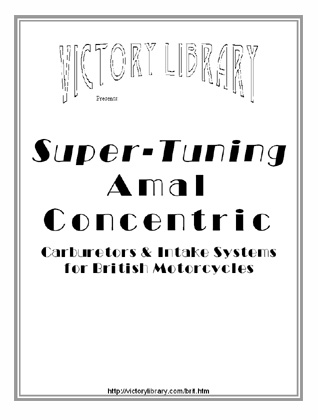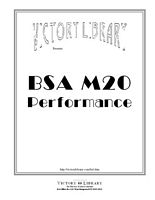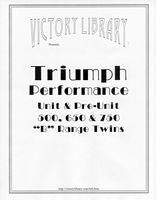 |
Flywheel Balance Factors “Flywheel balancing” is the term commonly used to describe making changes in the weight of certain areas of the flywheels (crank-shaft) to compensate for the weight of the other components. It is necessary for any motor’s flywheels to be “in balance” to operate without damage. All flywheels are balanced at the factory, but not to the same degree of precision as would be required for racing, or even by a careful owner. The Harley-Davidson factory balance is only production-line quality, and can be improved upon by diligent effort. In a V-twin this is especially important, as these motors are inherently out of balance due to the irregular nature of the firing impulses, and movement of the components.
The purpose of this Paper is not to discuss how motors are balanced, but to explore what factors affect the degree of compensation (the “balance factor” ) to be used to achieve “correct” balance. | Component Definitions: | The entire flywheel assembly must balanced (with the exception of certain rotating components marked * in the list below). The calculation requires dividing the components into 2 separate categories: | Rotating weight, which is always in (generally) circular motion, and varies speed with engine RPM. Included are: | | » | left & right flywheel halves | | » | crank-pin, key, roller bearings, cages, nuts & locks | | » | lower half of both connecting rods, including the rod races | | » | sprocket & pinion shafts, key(s), roller bearings, cages, nuts & locks* (although theoretically part of the flywheel assembly, these components have almost literally no effect on balance due to their low weight, radially-symmetrical cross-section and very small radius of rotation). | Reciprocating weight, which is always in (generally) bi-directional linear motion: accelerating from fully stopped @ TDC, traveling down, slowing & stopping @ BDC, then reversing and accelerating in the other direction, slowing & stopping, etc. The components (again, generally) come to a complete halt twice in every revolution of the motor. These components vary speed with engine RPM, but vary direction based on flywheel positon. Included are: | » | both pistons | » | piston pins, rings & locks | » | upper half of both connecting rods, including the piston pin bushings. | All methods involve separating the rod weight into reciprocating vs. rotating weight by suspension of the rod(s) by one end and weighing the other, carefully keeping the beam axis exactly horizontal. The process is then reversed, giving the weight of the opposite end. The total (of course) equals the exact weight of the rod. However... this makes the separation of reciprocating vs. rotating weights dependent on the center of gravity, which is NOT a relevant factor for balancing purposes. The exact center of the big end (the main race insert, for example) is pure rotating weight (no rectilinear motion), whereas the pin eye & bushing is pure reciprocating weight (no rotational motion). If you stretched a rod by 1” in the exact balance center (without adding any weight), the suspension-derived weight & proportions would not change, but clearly the effect of the new rod on balance would change, because the point of distinction between the reciprocating and rotating ends is at the geometric center, not the center of gravity. Since the big end is always much heavier than the small end, the center of gravity will only begin to locate at the geometric center (50% of the center to center distance) in a rod of infinite length; shorter rods will tend to have more bias between the C-of-G and geometric center. Therefore, the absolute length of the rod (as well as the rod ratio) has an effect on balance.
This (partially) explains why some factors work better on some motors. Motors with higher “n” values (long rod, short stroke, rod-to-stroke ratio in the 1.75 - 2.1-1 range) have lower out-of-balance forces: the mostly linear upper end of the beam walks back and forth through a smaller range, and its maximum angle from vertical is smaller. Lower “n” value motors' (short rod, long stroke, rod-to-stroke ratio in the 1.45 - 1.75-1 range) rod beams swing through a greater arc as the maximum deflection from vertical is greater - more of the force is vectored at the cylinder wall (rather than at the crank-pin). This affects selection of balance factor. In my opinion, the separation (and assignment of weight fractions to rotating vs. reciprocating) MUST include some compensation for the length of the rod (as well as the rod to stroke ratio). An interesting experiment would be to see where the mathematical center is (50% of center-to-center distance; 3.71875” from either end of a 45, Sportster & 1973-* big twin rod) vis-a-vis the balance point derived by the C-of-G (suspended) method. |
Factors Affecting Balance:
| There have been many formulae published to calculate the exact amount of adjustment to make to the flywheels to compensate for these factors. The adjustment is usually made by removing metal from the rim directly opposite the center of an imbalance caused by excess weight. Of course, it’s also possible to add weight, but this is more complex and not generally the first choice. If a known and trusted “balance factor” (math formula or selection of components) is used, the level of reliability and rider comfort in improved. However, even excellent application of the wrong factor may cause very unsatisfactory results - don’t be creative! Actually, no formula is “correct”, some just come closer than others, by the “empirical” method - they've been tried & adjusted by experiment. All formulae are compromises based on motor details, but also including such dimensional & physical factors as: | » | Rod to stroke length ratio: small ratios (long stroke, short rod) have higher out-of-balance forces. | | » | Angle between the cylinders: Harley-Davidson twin-cylinder motors (except the 1920 Sport, and VR) all have their cylinders placed 45° apart, but this is certainly not the only practical method. For example: most Indian twins are 42°, various Japanese twins are between 60 & 70°, Ducati, Moto Guzzi & Indian 841 military twins are 90°, and BMW, Marusho, Honda Gold Wing, Ural, Douglas, Harley-Davidson Sport & XA are 180°. The “V” angle is frequently a whole fraction of a circle: 45° is 1/8, 60° is 1/6, etc. (Indian being the oldest exception). Large aircraft radial engines were designed with 27 cylinders: 9 banks of 3 in-line cylinders each, 40° apart. | | » | RPM range normally used: a wide range must be more forgiving of “bad spots”. The calculation must be made for the entire range, not just the power curve (except for racing). | » | Amount of power developed: if necessary, the durability of the motor is given preference to the rider’s comfort. | » | Rider tolerance of vibration: how long will the machine be ridden? By whom? | » | Type of engine mount: solid? Rubber? Unit construction? How many points of attachment? | » | Type of chassis: rubber mount? Belt drive? Isolated handlebars & footpegs? | <
Dynamic Factors; Motion vs. Direction: | The reciprocating components of a V configuration behave quite differently from those of an single-cylinder, in-line or opposed (180°) motor. Using the Harley-Davidson 45° twin for example, let’s begin in mid-stroke (90° BTDC) with the pistons rising towards TDC. Both pistons (and the other reciprocating components, as listed previously) are moving in the same direction (even though not in the same positions or at the same speeds). However, as the front piston reaches 45° BTDC the rear piston has stopped at TDC. As the front piston rises to 44° BTDC, the rear piston is at 1° ATDC (the 45° separation angle is still present), and has begun to move down. The pistons will continue to move in opposite directions for 45° of flywheel rotation, until the front piston reaches TDC (rear piston is at 45° ATDC), after which both will be moving down.
A similar effect occurs approaching & passing BDC. The relative directions of the pistons are the same, but the exact positions are different due to the difference in piston speed at the bottom of the stroke (the TDC motion vs. BDC motion speed differential and exact piston position are functions of the rod-to-stroke ratio). Only at 22½° from TDC and BDC are the 2 pistons in the same absolute position. | | From front piston position 45° BTDC to TDC and 45° BBDC to BDC, the front and rear pistons are moving in opposite directions. | The selection of the “V” angle itself
adds another complex factor to motor design. The narrow V angles (42°, 45°, etc.) have a relatively short period in which the reciprocating weights of the two cylinders are moving in different directions - the same as the V angle (45° is only 12.5% of the full 360° rotation of the flywheel). However, the out of balance forces are relatively high, and balancing is generally successful only over a narrow range of engine speed. As the V angle widens (60°, etc.) the periods in which the reciprocating weights are moving in different directions increases (60° is 16.67% of the full 360° rotation of the flywheel), which appears to make the problem worse, but the wider V angle motors appear more tolerant of wider and higher RPM ranges, and the net effect is an improvement. However, these motors generally require a longer and lower engine bay for clearance, which frequently changes the entire frame design, including the wheelbase, center of gravity, swing-arm length, gas tank position, etc. |
The bottom line is that the physics and mathematics involved in how the motor operates are far too complex to make a formula-based balance factor any more than a reasonable compromise. These are only the factors that I've personally detected; there are certainly more (of greater or lesser effect) than I am not capable of adequately describing, such as the elasticity of components, harmonic resonance, gyroscopic forces, precession, etc.
Once the factor has been selected, the remaining tasks are accurately to record the component weights, and precisely adjust the flywheels to compensate. Your motor will last longer and be more pleasant to ride afterwards.
My opinion: don’t try to be an innovator in selecting a balance factor; use one that has stood the test of time & experience, and has been successful in a motor very similar to yours (especially with regard to stroke & rod length, piston gram weight, operating RPM range, and compression ratio).
|
See these other Victory Library booklets | 
| 
| 
| 
| 
| 
| ") 
| 
|
|